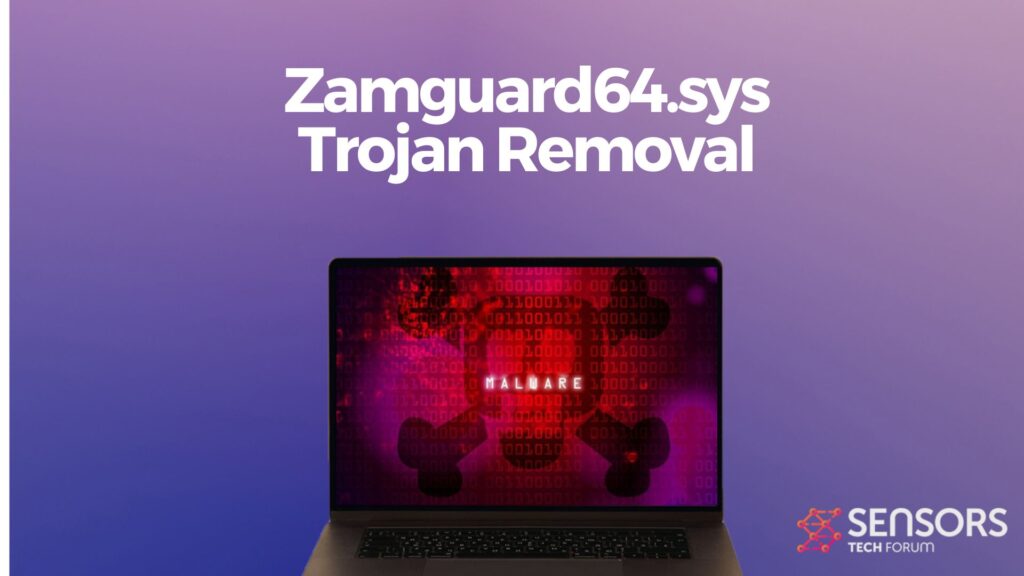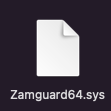What is Zamguard64.sys?
Zamguard64.sys is a destructive online threat with the potential to cause severe harm to your device. It possesses the ability to steal and tamper with data, breach passwords, and monitor online activities. To shield your digital assets, it’s vital to know how to eradicate Zamguard64.sys. This article will delve into the details of this malevolent application and guide you on how to completely remove it from your system.
What is a Trojan?
Trojans are a type of malicious software (malware) that act as a concealed entrance for cybercriminals, enabling them to bypass standard security protocols and gain unauthorized access to systems. Once infiltrated, they can remotely control the system, execute commands, and secretly introduce additional malware.

Zamguard64.sys Summary
| Name | Zamguard64.sys |
| Type | Trojan Horse |
| Brief Description | Intends to perform mining tasks for BitCoin and spyware activities as well. |
| Symptoms | Your computer may become significantly slow and may freeze intermittently. |
| Distribution Technique | Enclosed downloads. Websites which may advertise it. |
| Detection Tool |
Verify If Your System Has Been Infected by Zamguard64.sys
Download
Malware Removal Tool
|
User Experience | Join Our Forum to discuss Zamguard64.sys. |
How Did I Get the Zamguard64.sys Trojan?
Unfortunately, Zamguard64.sys is a program engineered to steal data and destabilize computing systems and isn’t readily detectable or able to function effectively. If this malware has penetrated your system, it’s advised to inspect your computer with a trustworthy anti-malware solution to eliminate it. Probable origins encompass:
- A flight ticket.
- A document pertaining to your earnings.
- An overdue payment notice.
- A digital receipt or invoice.
What Does the Zamguard64.sys Virus Do?
This harmful software is a perilous malware variant that breaches a system via a concealed entry point and generates files in critical Windows directories. Furthermore, it launches Bitcoin Miner virus programs, which can inflict serious system damage and expose all stored information to other malicious activities.
The virus files associated with this threat can be located in these Windows directories:

- %Local%
- %AppData%
- %Temp%
- %Windows%
Zamguard64.sys can potentially impair these Windows Registries:
HKEY_LOCAL_MACHINE\Software\Microsoft\Windows\CurrentVersion\Run
HKEY_LOCAL_MACHINE\Software\Microsoft\Windows\CurrentVersion\RunOnce
HKEY_CURRENT_USER\Software\Microsoft\Windows\CurrentVersion\Run
HKEY_CURRENT_USER\Software\Microsoft\Windows\CurrentVersion\RunOnce
How Dangerous is Zamguard64.sys?
As a Trojan virus, Zamguard64.sys poses a serious menace to your device. It has the capability to perform a variety of malicious activities:
- Download other detrimental software.
- Control and update its miners.
- Capture screen images.
- Steal files.
- Record your keystrokes.
- Harvest data from your PC.
- Operate your microphone and audio.
What Should I Do If I Detect Zamguard64.sys?
If this virus is discovered on your device, immediate response is crucial. The most effective strategy for removal involves using a dedicated anti-malware utility.
Who Do We Assist?
Our aim is to support those affected by this virus. For this reason, we’ve compiled comprehensive guides for all operating systems to help detect and remove the virus, and also prevent future infections.
How to Remove the Zamguard64.sys Virus from Your Computer
To excise this backdoor Trojan from your computer infrastructure, you need to comply with the three-step guide given below. It’s essential to execute these steps thoroughly to effectively cleanse your system from the virus and enhance your system security.
Preparation before removing Zamguard64.sys.
Before starting the actual removal process, we recommend that you do the following preparation steps.
- Make sure you have these instructions always open and in front of your eyes.
- Do a backup of all of your files, even if they could be damaged. You should back up your data with a cloud backup solution and insure your files against any type of loss, even from the most severe threats.
- Be patient as this could take a while.
- Scan for Malware
- Fix Registries
- Remove Virus Files
Step 1: Scan for Zamguard64.sys with SpyHunter Anti-Malware Tool



Step 2: Clean any registries, created by Zamguard64.sys on your computer.
The usually targeted registries of Windows machines are the following:
- HKEY_LOCAL_MACHINE\Software\Microsoft\Windows\CurrentVersion\Run
- HKEY_CURRENT_USER\Software\Microsoft\Windows\CurrentVersion\Run
- HKEY_LOCAL_MACHINE\Software\Microsoft\Windows\CurrentVersion\RunOnce
- HKEY_CURRENT_USER\Software\Microsoft\Windows\CurrentVersion\RunOnce
You can access them by opening the Windows registry editor and deleting any values, created by Zamguard64.sys there. This can happen by following the steps underneath:


 Tip: To find a virus-created value, you can right-click on it and click "Modify" to see which file it is set to run. If this is the virus file location, remove the value.
Tip: To find a virus-created value, you can right-click on it and click "Modify" to see which file it is set to run. If this is the virus file location, remove the value.Step 3: Find virus files created by Zamguard64.sys on your PC.
1.For Windows 8, 8.1 and 10.
For Newer Windows Operating Systems
1: On your keyboard press + R and write explorer.exe in the Run text box and then click on the Ok button.

2: Click on your PC from the quick access bar. This is usually an icon with a monitor and its name is either “My Computer”, “My PC” or “This PC” or whatever you have named it.

3: Navigate to the search box in the top-right of your PC's screen and type “fileextension:” and after which type the file extension. If you are looking for malicious executables, an example may be "fileextension:exe". After doing that, leave a space and type the file name you believe the malware has created. Here is how it may appear if your file has been found:

N.B. We recommend to wait for the green loading bar in the navigation box to fill up in case the PC is looking for the file and hasn't found it yet.
2.For Windows XP, Vista, and 7.
For Older Windows Operating Systems
In older Windows OS's the conventional approach should be the effective one:
1: Click on the Start Menu icon (usually on your bottom-left) and then choose the Search preference.

2: After the search window appears, choose More Advanced Options from the search assistant box. Another way is by clicking on All Files and Folders.

3: After that type the name of the file you are looking for and click on the Search button. This might take some time after which results will appear. If you have found the malicious file, you may copy or open its location by right-clicking on it.
Now you should be able to discover any file on Windows as long as it is on your hard drive and is not concealed via special software.
Zamguard64.sys FAQ
What Does Zamguard64.sys Trojan Do?
The Zamguard64.sys Trojan is a malicious computer program designed to disrupt, damage, or gain unauthorized access to a computer system. It can be used to steal sensitive data, gain control over a system, or launch other malicious activities.
Can Trojans Steal Passwords?
Yes, Trojans, like Zamguard64.sys, can steal passwords. These malicious programs are designed to gain access to a user's computer, spy on victims and steal sensitive information such as banking details and passwords.
Can Zamguard64.sys Trojan Hide Itself?
Yes, it can. A Trojan can use various techniques to mask itself, including rootkits, encryption, and obfuscation, to hide from security scanners and evade detection.
Can a Trojan be Removed by Factory Reset?
Yes, a Trojan can be removed by factory resetting your device. This is because it will restore the device to its original state, eliminating any malicious software that may have been installed. Bear in mind that there are more sophisticated Trojans that leave backdoors and reinfect even after a factory reset.
Can Zamguard64.sys Trojan Infect WiFi?
Yes, it is possible for a Trojan to infect WiFi networks. When a user connects to the infected network, the Trojan can spread to other connected devices and can access sensitive information on the network.
Can Trojans Be Deleted?
Yes, Trojans can be deleted. This is typically done by running a powerful anti-virus or anti-malware program that is designed to detect and remove malicious files. In some cases, manual deletion of the Trojan may also be necessary.
Can Trojans Steal Files?
Yes, Trojans can steal files if they are installed on a computer. This is done by allowing the malware author or user to gain access to the computer and then steal the files stored on it.
Which Anti-Malware Can Remove Trojans?
Anti-malware programs such as SpyHunter are capable of scanning for and removing Trojans from your computer. It is important to keep your anti-malware up to date and regularly scan your system for any malicious software.
Can Trojans Infect USB?
Yes, Trojans can infect USB devices. USB Trojans typically spread through malicious files downloaded from the internet or shared via email, allowing the hacker to gain access to a user's confidential data.
About the Zamguard64.sys Research
The content we publish on SensorsTechForum.com, this Zamguard64.sys how-to removal guide included, is the outcome of extensive research, hard work and our team’s devotion to help you remove the specific trojan problem.
How did we conduct the research on Zamguard64.sys?
Please note that our research is based on an independent investigation. We are in contact with independent security researchers, thanks to which we receive daily updates on the latest malware definitions, including the various types of trojans (backdoor, downloader, infostealer, ransom, etc.)
Furthermore, the research behind the Zamguard64.sys threat is backed with VirusTotal.
To better understand the threat posed by trojans, please refer to the following articles which provide knowledgeable details.


